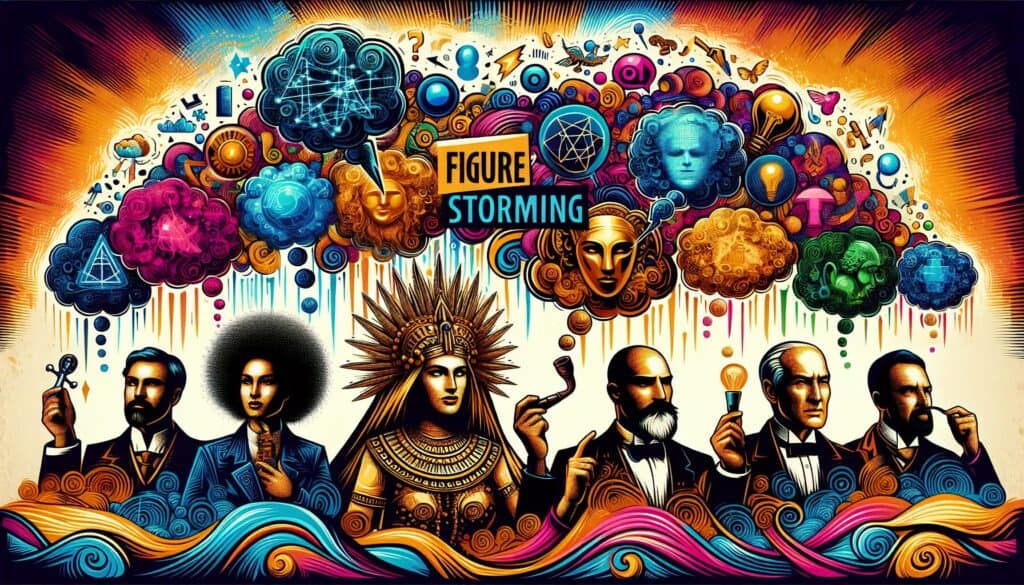A brainstorming technique where participants adopt the persona of a well-known figure (e.g., a famous innovator, a historical figure, a fictional character) and generate ideas from that perspective.
- Methodologies: Customers & Marketing, Economics, Product Design
Figure Storming (Rolestorming with well-known figures)

Figure Storming (Rolestorming with well-known figures)
- Brainstorming, Creativity, Cross-Functional Collaboration, Design Thinking, Human-Centered Design, Ideation, Innovation, User experience (UX), User-Centered Design
Objective:
How it’s used:
- Participants choose or are assigned a well-known persona and then brainstorm ideas or solutions as if they were that person, considering their traits, knowledge, and approach.
Pros
- Helps break free from personal biases and ingrained thinking patterns; encourages more creative and out-of-the-box ideas; can be fun and engaging.
Cons
- Effectiveness depends on how well participants can embody the chosen personas; some personas might not be relevant to the problem at hand; could lead to less practical ideas if not grounded.
Categories:
- Ideation, Problem Solving
Best for:
- Generating creative ideas by adopting the perspective and characteristics of a well-known individual.
Figure Storming can be effectively utilized in the ideation phase of product design and innovation processes across various industries such as technology, fashion, automotive, and healthcare, where creative brainstorming is essential to developing new concepts. For instance, a team designing wearable health tech could adopt the persona of Steve Jobs to explore revolutionary features, pushing the boundaries of functionality and user experience seen in Apple’s ecosystem, while a fashion design team might embody Coco Chanel to appreciate timeless elegance and innovation in materials and style. Participants typically include cross-disciplinary teams such as designers, engineers, marketing strategists, and even stakeholders from different sectors who can provide diverse viewpoints when embodying different figures. By engaging in this method, teams can bypass conventional thinking patterns and preconceived notions regarding product limitations. This encourages a playful atmosphere that leads to unexpected ideas, as team members leverage the idiosyncrasies, problem-solving skills, and innovative approaches of the personas they represent. Organizations aiming to cultivate a culture of innovation often promote such methodologies in workshops, brainstorming sessions, or design sprints, making it a strategic tool conducive to encouraging collaboration and tapping into the imaginative potential of diverse teams.
Key steps of this methodology
- Choose or assign a well-known persona relevant to the problem.
- Research key traits, knowledge, and approaches of that persona.
- Brainstorm ideas or solutions as if you were that persona.
- Encourage participants to react to each other's ideas from their chosen persona's viewpoint.
- Document all ideas generated during the session without criticism.
- Evaluate and refine ideas considering the personas’ perspectives afterward.
Pro Tips
- Incorporate historical context and challenges faced by the chosen figure to enrich discussions and uncover unconventional solutions.
- Encourage participants to adopt not only the figure's persona but also their decision-making criteria, leading to more authentically innovative ideas.
- Use props or visuals representing the figure's work or achievements to stimulate imagination and create a more immersive brainstorming experience.
To read and compare several methodologies, we recommend the
> Extensive Methodologies Repository <
together with the 400+ other methodologies.
Your comments on this methodology or additional info are welcome on the comment section below ↓ , so as any engineering-related ideas or links.
Historical Context
1949
1950
1950
1960
1960
1960
1960
1940
1950
1950
1958
1960
1960
1960
1960
(if date is unknown or not relevant, e.g. "fluid mechanics", a rounded estimation of its notable emergence is provided)















Related Posts
Musculoskeletal Discomfort Questionnaires
Multivariate Testing (MVT)
Multiple Regression Analysis
Motion Capture Systems
MoSCoW Method
Mood’s Median Test